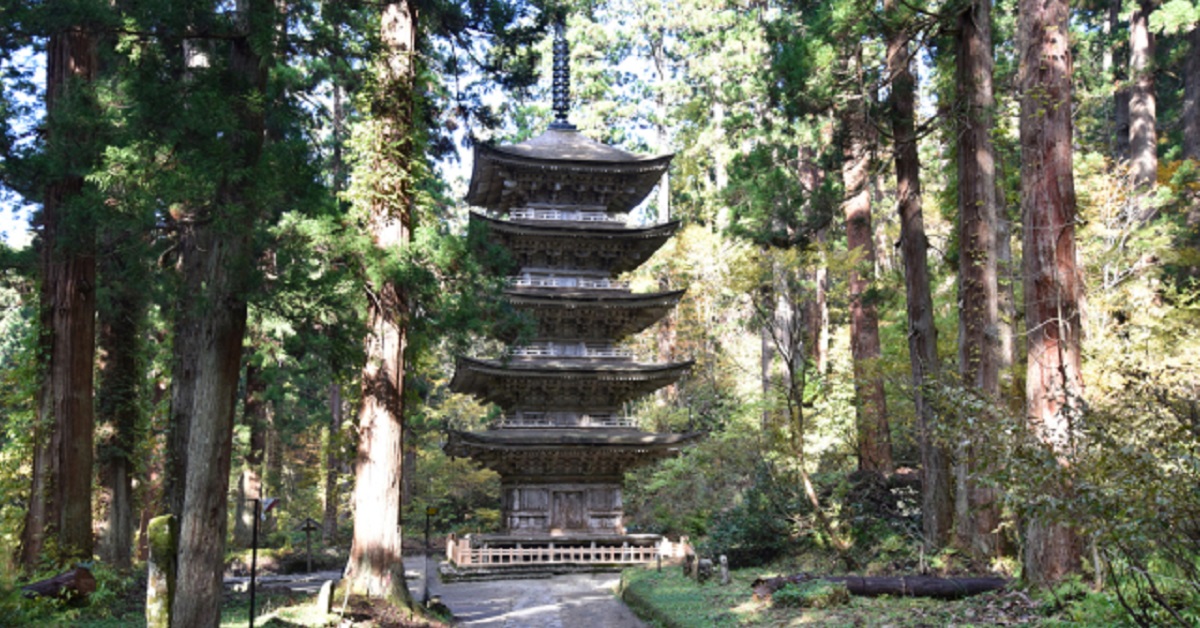The Haguro Five-Story Pagoda is a national treasure and the only five-story pagoda in the Tohoku region. Nestled in a sacred forest on Mount Haguro, it embodies the harmony of traditional Japanese architecture and nature worship. With a history dating back over six centuries, the tower offers foreign visitors not just sightseeing but a profound cultural and spiritual experience.
Basic Information about the Haguro Pagoda
The Haguro Five-Story Pagoda is a wooden structure about 29 meters tall, built in the style of Shirakizukuri (unpainted natural wood construction). While some legends say it was first established in the Heian period, the current structure is believed to have been rebuilt around 1372, during the early Muromachi period. According to tradition, the warrior Taira no Masakado was the first to build it.
Basic Data Table
| Item | Details |
|---|---|
| Name | Haguro Five-Story Pagoda (Haguro-san Goju-no-to) |
| Location | Tsuruoka City, Yamagata Prefecture |
| Height | About 29 meters |
| Reconstruction Date | Early Muromachi Period (around 1372) |
| Legendary Founder | Taira no Masakado |
| Architectural Style | Shirakizukuri (natural unpainted wood construction) |
| Designation | National Treasure (the only five-story pagoda in Tohoku) |
Architectural Features
The most striking feature of the Haguro Pagoda is its Shirakizukuri construction, in which the natural texture of wood is preserved without paint. Over the centuries, the wood has darkened and harmonized with the surrounding forest, giving the tower a profound and serene beauty.
The pagoda consists of five tiers, each roof designed with subtle curves that create balance and grace. Supported by a central pillar and an intricate wooden framework, the structure has withstood more than 600 years of earthquakes in Japan, demonstrating the ingenuity of traditional carpentry.
Surrounded by centuries-old cedar trees, the tower appears as if it is an extension of nature itself. This creates an atmosphere where visitors can experience the Japanese aesthetic of harmony with nature.
Historical Background
Mount Haguro is the spiritual center of the Dewa Sanzan (Three Sacred Mountains: Haguro, Gassan, and Yudono). For centuries, it has been a holy site of mountain worship and Shugendo practices. The five-story pagoda became a symbol for pilgrims, embodying both spiritual discipline and reverence for nature.
Despite centuries of warfare and natural disasters, the Haguro Pagoda has survived thanks to the devotion of local communities. Its preservation across generations is itself miraculous, and it is one of the key reasons it was designated as a national treasure.
Seasonal Highlights
The Haguro Pagoda offers a different charm each season, making it a unique destination for foreign travelers to experience Japan’s four distinct seasons.
Seasonal Highlights Table
| Season | Scenic Features |
|---|---|
| Spring | Fresh greenery and vibrant life |
| Summer | Cool shade and refreshing air |
| Autumn | Brilliant red and golden leaves contrasted with the tower |
| Winter | A solemn, snow-covered landscape |
The seasonal transformations of the pagoda create a new impression each time, ensuring that every visit feels fresh and inspiring.
Visiting and Access
The Haguro Pagoda is located along the main pilgrimage trail of Mount Haguro, which consists of about 2,446 stone steps. Walking the cedar-lined path is considered a sacred journey. While most visitors choose to climb on foot, buses are available to shorten the route for those who need assistance.
Access Table
| Method | Details |
|---|---|
| On Foot | Climb the stone steps while enjoying nature |
| Bus | Shuttle buses run from the base to the summit of Mount Haguro |
| Car | About 40 minutes from central Tsuruoka City, parking available |
| Nearest Airport | Shonai Airport, about 40 minutes by car |
For those seeking to experience the spiritual side of Japan, walking the pilgrimage path is highly recommended.
Recommended Experiences for Foreign Visitors
For international travelers, visiting the Haguro Pagoda is more than sightseeing—it is a cultural journey. Recommended experiences include:
- Walking the cedar-lined pilgrimage path – Feel the spirituality of mountain worship.
- Silent reflection near the tower – Despite being a tourist site, the atmosphere is calm and contemplative.
- Photography – Early morning or misty scenes of the pagoda create mystical images.
- Visiting in all four seasons – Each season offers a completely different atmosphere, making repeat visits worthwhile.
Nearby Attractions and Cultural Experiences
A trip to the Haguro Pagoda can be combined with visits to nearby cultural sites and local food experiences. The surrounding area offers opportunities to understand Japanese spirituality, history, and lifestyle.
Nearby Attractions Table
| Spot | Features |
|---|---|
| Dewa Sanzan Shrine | Located at the summit of Mount Haguro, center of the Three Mountain worship |
| Mount Gassan | Popular for summer climbing, regarded as a sacred peak |
| Mount Yudono | Home to a mysterious sacred object, considered deeply holy |
| Tsuruoka City | Historic castle town with samurai residences and traditional streets |
The region is a rich blend of faith, nature, historical architecture, and food culture, making it a rewarding travel destination.
Conclusion
The Haguro Five-Story Pagoda is the only national treasure pagoda in Tohoku, embodying the harmony between traditional Japanese architecture and nature worship. Its Shirakizukuri design, centuries of history, and seasonal beauty provide foreign visitors with a profound cultural experience.
Climbing the path to the pagoda is not just tourism—it is a spiritual journey that conveys Japanese values of nature and faith. Visiting the Haguro Pagoda allows travelers to immerse themselves in an essential part of Japan’s cultural and spiritual heritage.
When traveling to Yamagata, the Haguro Pagoda is a must-see destination that will leave an unforgettable impression.






